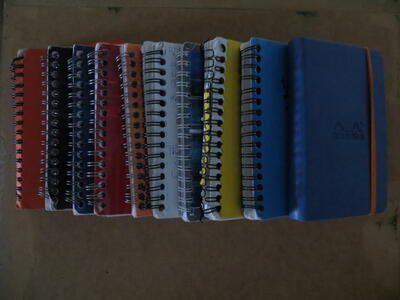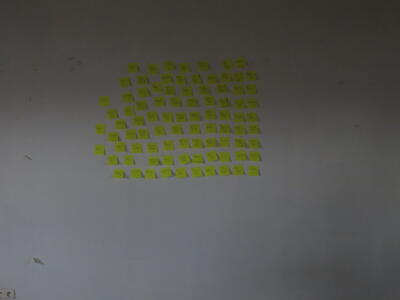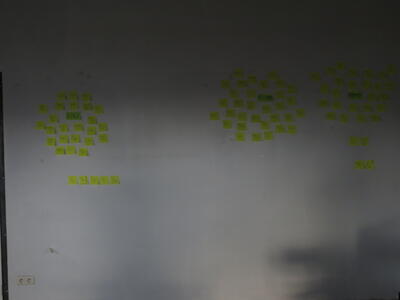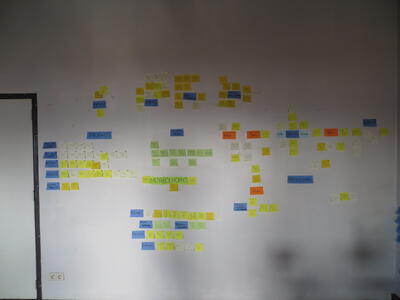Collection Phase
Paper Notebooks
I have been offered this Transiency in June 2012, and wrote down any inspiring topic I may want to address during this period until the actual start of the Transiency, in November 2013.
As I do not have smartphone, I use old style paper notebooks to write down burning questions/comments/ideas, references and field notes. I write down stuff almost everyday, on quite many different topics. Therefore, I decided to ease the browsing process by adding up small tags into brackets to whatever I was writing down. Here are some tag examples:
- [REF] is used for litterary and online references
- [LMK] is used for Landmark Papers
- [PROJ] is used for projects I would like to implement in the future
- [FUT] is used for mid-term to long-term ideas of what I may like to do as a profession in the future.
- [ADR] is mainly used when I travel for addresses I would like to remember, like nice coffee places, or spots to watch beautiful landscapes.
- [GDS] is used to record transient magical moments I would like to remember over the long term.
- [FoAM2013] was used to record any Transiency-related content.
One major phase of the project definition process was therefore to browse the eight notebooks I filled since June 2012 to gather any [FoAM2013]-labeled content.
Numerical Content
When doing online search, I directly used the computer to write down inspirationnal material regarding the Transiency. In my “numerical & online notebooks”, I had:
- Web bookmarks into the bookmark management tool Diigo under the label “FoAM2013”
- As I did not use my personal computer at work, I also had to process E-mails with links grouped under the label “FoAM2013”
- A text document called “FoAM 2013” for random non-links stuff like keywords and direct references to activities or Metabolhomics processes
- A folder called “FoAM 2013” filled up with PDFs to read, images, and other stuff.
All this material was classified together with the Paper Notebooks material.
Classification Phase
Post-it Classification Phase
Some of this content was outdated, so I decided to operate a first filtering step at the root level, and gathered onto post-its only the topics which still seemed relevant to address in November 2013. This induced lack of traceability, as I have no direct access to the whole set of topics I would have liked to adress during this Transiency. However, it lightened the amount of material to sort, which was already representing much more than the amount I would be able to work on within a year.
I started by just accumulating post-its in a unordered way during one browsing day. Ordering seems easier when you reached a kind of critical mass.
From this critical mass emerged a first classification in three categories:
- Practices: a set of activities I want to learn or practice during this year.
- Metabolhomics: elements regarding the DIY upcycled bio-based self-sufficient habitat I plan to map and prototype this year.
- Language: a set of keywords describing the approach, methods and activities performed during this Transiency.
More details about the sorting algorithm which helped me sort this into categories are available here.
After more days of notebook content gathering, a bigger amount of post-its allowed to define sub-categories to the first basic classification scheme. Some categories where restructured when balance in the content would change with the growing number of post-its.
As more post-its were added to the wall, further sub-categories where created, some specific contents were highlighted by being put on post-its with different colors. The final result of the post-it classification looked like the following picture - where you can only see the classification of the Metabolhomics category.
Post-its have mainly been used as precursors of mindmaps. Post-its are quite handy because they - theoretically - can be re-positionned several times and still stick to the surface. When dealing with large amounts of content to classify, I think that post-its are handy for three reasons:
- You get physical with your ideas
- You are able to do and undo classification schemes in very intuitive and quick way
- You can keep an holoptic view more easily with a big wall than with a small screen
However, as you do not want to archive your wall forever with the right classification, I have then switched to mindmaps.
Mindmaps
Thanks to the freeware version of XMind, I obtained compact and readable mindmaps out of my quickly-handwritten-and-unsticky-anymore-post-its.
I kept almost exactly the same organization than on my wall, and obtained, for instance, the two following maps:
The content may look a bit cryptic to you, but I promise I can understand myself better than with the post-its :)
In addition to these mindmaps which define project strategy from high- to low- level content, I created a workbook for more practical sutff. Logically, I called it “Practical FoAM2013”.
Practical FoAM2013 Tables
This Open Office workbook contains eight tabs:
- A General Objectives List, where I write down things I would be sad not to have achieved at the end of the year.
- A Short-Term To-Do List, where I write down short-term tasks I want to achieve in the following days.
- A Reading/Watching/Listening List where is stored all the references collected in my paper and numerical notebooks.
- An Exploration List, complementary to the previous one, where I write down names and keywords about topics I found interesting, and I would like to dig into a little bit more.
- A Connected Projects List, where I list projects I feel are connected to Metabolhomics and the general spirit of this Transiency.
- A People I Should Connect With List, where I list… people I should connect with.
- A Diffusion List, where I start to list contacts of people interested with my work, and to whom I should send some kind of newsletter.
- A Questions List, where I list the topic I would like to adress during my regular meetings with FoAM's Core Team members.
This workbook articulates day-to-day Project Management elements like the Short-Term To-Do List with more global Project Definition elements, like the General Objectives list.
Scheduling
The next task is to produce a schedule of activities, showing how they will articulate until the end of the year.
Right now, the schedule is pretty rough, as it only cuts the whole Transiency in two main phases.
- The *Definition phase (November-March)*, during which gathering and processing of informations are the main tasks. I will be involved with research, reading, mapping and design tasks to prepare the second phase, which will be…
- The *Implementation phase (April-November)*, during which I will prototype a system of objects out of the Metabolhomics Map.
A more detailed schedule is currently under construction.
TODO
Processing language: essential key words and essential anti-key words.
Getting physical TD link



